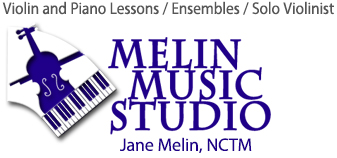- Baroque repertoire in the advanced levels often has extended double-stop passages featuring counterpoint (2 melodies playing at once). The Bach Unaccompanied Sonatas and Partitas are core repertoire at the top 3 levels.
- Classical works by Mozart and Beethoven should be explored by every student.
- Romantic advanced repertoire often consists of show-pieces composed to spotlight the violinist’s technical skills. Sometimes the musicality of the piece can be overshadowed by the showoff factor. Be sure you choose pieces that appeal to you melodically, or have technical flair that you would like to learn to play (such as gypsy-style), or you may grow tired of working on the piece before you have mastered it.
- Selections from the Contemporary period often feature complex harmonies and dissonances. It is good to explore this music to broaden your horizons and prepare for orchestral playing or auditions; choose at least one piece between Level 7 and Level 10 in this genre.
Requirements:
One fast concerto movement or substantial piece from any period (List A), one short piece in contrasting style (List B) and a movement from a Bach solo Sonata or Partita. All memorized. Pieces marked with * or ** are considered core repertoire; choose at least one piece that has a */**.
**These are Mrs. Melin’s favorites from the core repertoire.
List A: Fast Concerto Movements or Major Repertoire
Baroque Period
Spohr: Concerto No. 9 in Dm, Op. 55
Viotti: Concerto No. 22
**Vivaldi: Autumn or Winter from “The Four Seasons” (complete)
Classical Period
**Mozart: Concerto No. 3 in G, K. 216, with full cadenza
**Mozart: Concerto No. 4 in D, with abbr. cadenza
*Mozart/Kreisler: Rondo in G
Romantic Period
*De Beriot: Scene de Ballet
**Vitali: Chaconne
Contemporary Period
**Bartok: Roumanian Folk Dances, play at least four.
Kabalevsky: Concerto in C, Op. 48
List B: Shorter Pieces
Classical Period
Mozart: Adagio in E, K. 261
**Beethoven: Romance in G
Beethoven: Sonata Op. 12, No. 1 in D
*Beethoven: Sonata Op. 34, No. 5 “Spring”
Romantic Period
Drdla: Fantasia on “Carmen” Op. 66
*Dvorak/Kreisler: Slavonic Dance No. 1 in Gm
Glazunov: Meditation
Grieg: Sonata in G, Op. 13, No. 2
*Kreisler: Liebesfreud
**Kreisler: Praeludium & Allegro
Kreisler: Schön Rosmarin
Contemporary Period
**Bartok: Roumanian Folk Dances, play two.
Bloch: Nigun, from “Baal Shem Suite”
Copland: Waltz and Celebration from “Billy the Kid”
De Falla/Kochanski: The Pantomime from El Amor Brujo
Joplin/Perlman: Elite Syncopations (from “Ragtime for Violin”)
Joplin/Perlman: The Entertainer (ibid.)
Sarasate: Malaguena, Op. 21, No. 1
Stravinsky: Dance Russe from “Petrouchka”
Bach: Solo Sonata or Partita
Partita 3 has the most playable selections at this level, as well as the Allemande from Partita 2.
